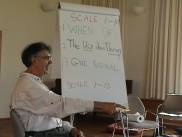 Auf den molekularen und neuroanatomischen Ebenen gibt es zunehmend Beweise, dass viele früh entwickelte Neuronen genauso wie erwachsen generierte eine zeitbegrenzte Existenz im Gehirn haben, die mit dem Wachstum und Verfall des Gedächtnisses und seinen Veränderungen durch Psychotherapie korreliert (Rossi, 2002). Lebendiges Gedächtnis ist ein Prozess von Konstruktion und Rekonstruktion über die Zeit. Diese Geschmeidigkeit oder Formbarkeit des Erinnerns kann das Verderben mündlich überlieferter Geschichte und von Berufen des Rechts sein, aber ich schlage vor, dass sie den essenziellen psychobiologischen Samen therapeutischer Hypnose und Psychotherapie genauso enthält wie viele alternative und die Medizin ergänzende Methoden, welche die ideodynamische Handlungshypothese der Suggestion einschließen. Zum Beispiel dokumentiert die gegenwärtige neurologische Forschung, wie der klassische Vorgang Pawlowscher Angstkonditionierung die Wiederholung und erneute Aktivierung eines konditionierten Gedächtnisses erfordert, ehe er gelöscht und/oder auf der Ebene der Genexpression und der Proteinsynthese rekonstruiert werden kann, wie experimentell von Nader et al. (2000a & b) gezeigt wurde. Nader et al. (2000 a) fassen ihre Forschung mit diesen Worten zusammen: "Unsere Daten zeigen, dass gefestigte Angsterinnerungen, wenn sie reaktiviert werden, zu einem verantwortlichen Status zurückkehren, der de novo [Genexpression] und Proteinsynthese zur Wiederverfestigung erfordert. Diese Ergebnisse werden nicht durch die traditionellen Theorien der Gedächtnisbildung vorhergesagt. (S. 723, kursiv hinzugefügt).
Auf den molekularen und neuroanatomischen Ebenen gibt es zunehmend Beweise, dass viele früh entwickelte Neuronen genauso wie erwachsen generierte eine zeitbegrenzte Existenz im Gehirn haben, die mit dem Wachstum und Verfall des Gedächtnisses und seinen Veränderungen durch Psychotherapie korreliert (Rossi, 2002). Lebendiges Gedächtnis ist ein Prozess von Konstruktion und Rekonstruktion über die Zeit. Diese Geschmeidigkeit oder Formbarkeit des Erinnerns kann das Verderben mündlich überlieferter Geschichte und von Berufen des Rechts sein, aber ich schlage vor, dass sie den essenziellen psychobiologischen Samen therapeutischer Hypnose und Psychotherapie genauso enthält wie viele alternative und die Medizin ergänzende Methoden, welche die ideodynamische Handlungshypothese der Suggestion einschließen. Zum Beispiel dokumentiert die gegenwärtige neurologische Forschung, wie der klassische Vorgang Pawlowscher Angstkonditionierung die Wiederholung und erneute Aktivierung eines konditionierten Gedächtnisses erfordert, ehe er gelöscht und/oder auf der Ebene der Genexpression und der Proteinsynthese rekonstruiert werden kann, wie experimentell von Nader et al. (2000a & b) gezeigt wurde. Nader et al. (2000 a) fassen ihre Forschung mit diesen Worten zusammen: "Unsere Daten zeigen, dass gefestigte Angsterinnerungen, wenn sie reaktiviert werden, zu einem verantwortlichen Status zurückkehren, der de novo [Genexpression] und Proteinsynthese zur Wiederverfestigung erfordert. Diese Ergebnisse werden nicht durch die traditionellen Theorien der Gedächtnisbildung vorhergesagt. (S. 723, kursiv hinzugefügt).
On the molecular and neuroanatomical levels there is increasing evidence that many early developmental as well as adult-generated neurons have a time-limited existence in the brain that is correlated with the growth and decay of memory and its transformations via psychotherapy (Rossi, 2002). Living memory is a process of construction and reconstruction over time. This malleability or plasticity of memory may be the bane of oral history and the legal profession, but I propose that it contains the essential psychobiological seed of therapeutic hypnosis and psychotherapy as well as many alternative and complementary approaches to medicine that involve the ideodynamic action hypothesis of suggestion. Current neuroscience research, for example, documents how the classical process of Pavlovian fear conditioning requires the recall and re-activation of a conditioned memory before it can be extinguished and/or reconstructed at the gene expression and protein synthesis level as demonstrated experimentally by Nader et al. (2000 a & b). Nader et al. (2000 a) summarize their research with these words, “Our data show that consolidated fear memories, when reactivated, return to a liable state that requires de novo [gene expression] and protein synthesis for reconsolidation. These findings are not predicted by traditional theories of memory consolidation (p.723, italics added).
Nader, K., Schafe, G., & Le Doux, J. (2000 b). The labile nature of consolidation theory. Nature Reviews: Neuroscience, 1, 216-219.
